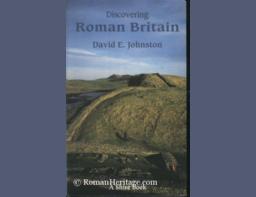RomanHeritage
is a non-profit cultural website about Ancient Rome, with Republican & Imperial Roman sites, roman ruins, Museums, books & movies, re-enactment groups, statues, Mosaics, frescoes, bronzes, etc.
Roman Heritage / Legado Romano
web sin ánimo de lucro sobre el Imperio romano, los yacimientos, ruinas romanas, museos, libros y películas, reconstrucción histórica, estatuas, mosaicos, frescos, etc.
Roman Heritage /Heredité Romaine
c'est une website sur l'empire Romain avec de Ruines romaines, museés, livres et films, groupes de reconstrucion historique, statues, mosaics et frescos.
Reino Unido Britannia

Almost all the information presented in this webpage for a better knowledge of the Roman Heritage in the United Kingdom has been obtained from the excellent book "Discovery Roman Britain" de David E. Johnston (please refer to his Editor's webpage www.shirebooks.co.uk), with a comprehensive list of places in the whole country, organized by Counties. Another magnificent book about the frontier in Britannia is "The Empire stops here. a Journey Along the Frontiers of the Roman World", by Philip Parker, edited by Pimlico (www.vintage-books.co.uk) with a detailed explanation of the itinerary of Hadrian's Wall, the Antonine Wall and the, so-called, Saxon Forts in the South and South-east.
The presence of the Romans in Britain started with the failed attempt by Julius Caesar in 55 & 54 B.C., but it was a short incursion, with no real consequences. Invasions by Augustus and Caligula were call off, for different reasons. It was almost a century later, in 43 A.D., under Emperor Claudius, when a Roman army crossed the Channel and conquered the Island, under Aulus Plautius, commanding four legions (Legio II Augusta, commanded by future emperor Vespasiano, Legio IX Hispana, Legio XIV Gemina and Legio XX Valeria Victrix).
The main names to remember are of those local leaders Togodumnus and Caratacus, and their tribe of the Catuvellani, as well as the welsh tribe of the Siluris. Also, it is worth to remember the names of Veranius and Gaius Suetonius Paulinus who campaigned successfully across Wales, destroying the druidical centre at Mona or Anglesey in AD 60. Finally, we must also remember Boudica or Boedicea, the most famous queen of the Iceni, who revolted, and leading also the Trinovantes, destroying Camulodunum (modern Colchester) and was finally defeated at St Albans by the former. A romantic statue riding a war Chariot can be seen near the Thames in London.
The Roman army was progressively retreated from the British Isles, as candidates to the Imperial throne move legion after legion to the Continent. Although the Romanized Britons keep Roman cultural traditions for many years, a common administration survived in Britain until the beginning of the 5th Century, where, de facto, Roman rule ceased to exist.
There are many things to see in England, Wales and Scotland, but our selection will focus in a shortlist of "must-see":
• Original and "Reconstructed" parts of Hadrian's Wall, with several highlights, but my favorite is the reconstruction of the West Gate on Arbeia, at South Shields at Durham. A reconstruction of the Commandant's house has been done, as well as a barrack block. Ruins and reconstruction may be also seen at Vindolanda Chesterholm, including a Roman army Museum. The Antonine Wall is not so well preserved.
• The "re-invented" Roman Baths at Bath in South West England (at Somerset). Although the actual structure is mainly from the XVIII Century, the ambiance is unforgettable.
• The so-called, "Insignia Room", with a theoretical reconstruction of those symbols.
• Some former roman cities with several remains, as Chester (at Cheshire), Colchester (at Essex), Silchester & Winchester (at Hampshire), St. Albans (at Hertfordshire), Dover & Rochester (at Kent), Lincoln (at Lincolnshire) and Caerleon at South Wales.
• Walls of three forts and some turrets, at Pevensey Castle (East Sussex), Burgh Castle (at Norfolk) and Caerwnt (South Wales
• Finally, the British Museum, not only for the British Roman Remains, but mainly for its Classical period collections.
The other remarkable thing about the United Kingdom is the number and quality of its re-enactment groups and units, of which we are giving a list obtained at internet, but we suggest you to keep yourself updated directly on the web.




